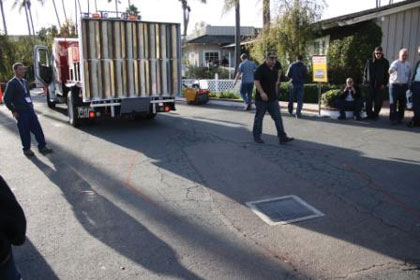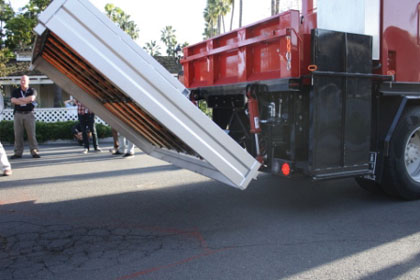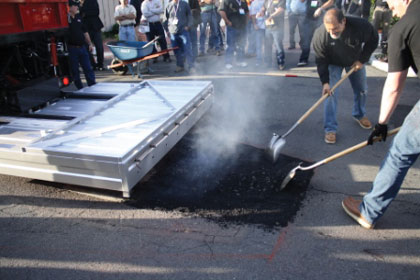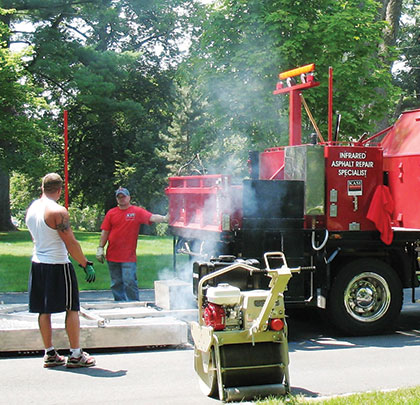Potholes, trench cuts, and other asphalt repairs are the bane of public works managers and road crews … ubiquitous, time-consuming, expensive to repair, tie up traffic, and are hazardous to passenger cars, trucks, cyclists, skaters, and pedestrians.
Now a new infrared asphalt repair technology enables city, county, and state road crews to save tons of time, material, and labor costs in repairing hazardous potholes, alligator cracking, failed utility cuts, and other surface defects that plague their asphalt streets and parking lots—year round.
SUPERIOR REPAIR
The infrared technique also provides superior repairs to roads, parking lots, and driveways at savings of up to two-thirds the cost of conventional methods. As opposed to conventional repair, which requires the removal of old asphalt from a damaged site and its replacement with new asphalt, the new infrared technology expedites repair by heating, fusing, and compacting recycled asphalt, saving equipment, labor, and new material in the process.
“The infrared system has enhanced our operations by reducing repair time and allowing us to repair larger surface areas,” says Steve Ortega, street operations foreman with Commerce City, Colorado (just north of Denver). “It also does a better repair than just filling a pothole or alligator cracking with new asphalt.”

TECHNOLOGY THAT SAVES
Ortega adds that using the city’s new asphalt repairing technology, purchased from Kasi Infrared Corp., his road crew can load up a couple of tons of asphalt and be busy all day. He adds that, in addition to saving time, the new infrared repair technology enables his crew to recycle a substantial portion of the old asphalt, saving on materials costs as well.
“In the past, we would take 4 or 5 tons out to the streets. But now, due to recycling, we just take out about 1.5 or 2 tons at the most. That’s because you’re able to rejuvenate and reuse much of the asphalt being repaired.”
COMMUNITY AWARENESS
Although not a large community, Ortega says Commerce City is conscientious about keeping the 700 or so lane-miles of its roadways in good condition.
While public safety from road hazards is always a high priority, exposure to liability claims may also be important to many local governments, particularly those who are self-insured.
The city of Moline, Illinois, relies on residents and drivers to provide updates on potholes and other road hazards. During the wintertime, the city offers a $50 reward to the person who reports the largest pothole.
“We take potholes and other types of failures very seriously,” Ortega says. “It doesn’t take much to create a hazard. It could be cracks or potholes or any type of imperfection. The infrared equipment has been a big help in overcoming problems quickly. You simply drop the heater on it, heat it up for awhile, rejuvenate much of the old, damaged asphalt, and then you resurface and seal it. The road surface is pretty much back to new when you’re done.”
Ortega adds that once sunlight has had time to bleach the new asphalt repair, it matches the original surface so much that you would be hard-pressed to locate the restoration.

INFRARED SYSTEM
The infrared equipment that Commerce City purchased is a trailer-mounted Kasi Proheat 2 Ton Minuteman model, a self-contained asphalt restoration system. It is ideal for permanently repairing all general asphalt defects, including potholes, surface cracking, utility cuts, trenches, birdbaths, and manholes.
The leading manufacturer of infrared asphalt restoration and repair equipment, Kasi offers a range of trailer-walk behind and truck-mounted systems and related equipment, including transportable compactors and other reclaiming and asphalt tools.
In operation, the infrared asphalt systems are much more efficient than traditional cut-and-remove asphalt repair. Kasi’s infrared pavement-heating panel with its Stainless Steel & Inconel Converters generates the Infrared radiation used to heat the asphalt pavement, softening it without damaging the asphalt 2 to 2.5 inches deep. Normal time is less than 7 minutes. The system’s reclaimer keeps asphalt at plant mix temperature in any kind of weather, and can also reclaim stockpiled asphalt.

BENEFITS ADD UP
Using an infrared asphalt reclaiming and repair system, the savings on labor and repair time, as well as materials, are very substantial. Infrared restorations fuse to the existing pavement, creating a continuous surface. This eliminates the need for tack-coating the edges because the seams have been eliminated, enhances durability, and allows roads to be opened to traffic immediately. It also makes the repair process less expensive, since existing asphalt is recycled, crew size is typically limited to two; and only a single truck or trailer is used.
These benefits have made the use of infrared systems highly popular with independent contractors who service state and local governments. ■
About The Author:
For more info, or to view a step-by-step video of how the asphalt infrared repair process works, call 800.450.8602, email info@kasiinfrared.com, or visit www.kasiinfrared.com.
_________________________________________________________________________
Modern Contractor Solutions, July 2013
Did you enjoy this article?
Subscribe to the FREE Digital Edition of Modern Contractor Solutions magazine.

Home Technology Solutions Year-Round Repairs: Infrared asphalt repair technology saves state and local governments tons
Year-Round Repairs: Infrared asphalt repair technology saves state and local governments tons


